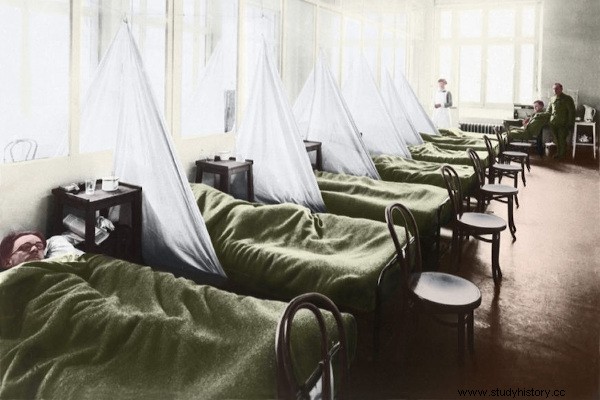The flu Spanish it was a pandemic that happened between 1918 and 1919, reaching all continents and leaving a balance of at least 50 million dead. Its place of origin is not known, but it is known that it started from a mutation of the Influenza virus. . The first cases were recorded in the United States.
The Spanish flu spread around the world, mainly due to the movement of troops during the First World War, having a direct impact on the countries participating in that conflict. Here in Brazil, it arrived in September 1918, spreading to all regions of the country and causing the death of 35,000 Brazilians.
Login also :Five diseases that marked the history of humanity
Where did it come from?

A number of studies have been conducted over the 20th and 21st centuries on the Spanish flu, and the origin of the disease remains a mystery. There are two theories that suggest it may have originated in China or in theUnited States , but there is no evidence that can confirm which of the two places it actually appeared for the first time.
What is known is that the Spanish flu was probably a mutation of the Influenza virus that passed from birds to humans. Furthermore, we know that the firsts cases that are known to have taken place in the United States and were recorded at Fort Riley , a military installation located in the state of Kansas.
The first patient was the soldier Albert Gitchell , who was admitted, with flu-like symptoms, to the infirmary at Fort Riley, March 11, 1918. In the following weeks, more than 1100 other soldiers from that location were admitted with the same symptoms. It is believed that the disease spread around the world through US troops participating in World War I.
Why is it called the Spanish flu?
If the Spanish flu started in the US or China, why do we call it the Spanish flu? The term “Spanish” does not refer to the supposed origin of the disease , but to the fact that the Spanish press became known for spreading her news around the world. The explanation for this is directly related to the First World War.
Spanish flu affected every continent in the world and had a huge impact on countries fighting in the First World War. Because of this conflict, it was necessary that the information about the disease be hidden so as not to harm the morale of the soldiers, not to create panic in the population or to transmit an image of weakness to the adversary.
Thus, news of this lethal flu was censored in most European countries. Spain, however, did not participate in the war, and its press was free to talk about the disease. This made the Spanish coverage known in the world , and the pandemic became known as the “Spanish flu.”
Login also :Brazil in World War I
Disease spread
Spanish flu spread across the world in three waves:
-
First wave :started in March 1918;
-
Monday wave :started in August 1918;
-
Third wave :started in January 1919.
Among these three waves, the second is known to be the most contagious and for having the highest mortality rates. The accepted thesis is that the disease initially spread around the world through US troops sent to Europe to participate in the First World War.
Once established on the European continent, the disease was carried to the rest of the world by displacement from people through travel or the international freight transport system. Here in Brazil, for example, she arrived, in September 1918, by a vessel that came from England and passed through Lisbon, Recife, Salvador and Rio de Janeiro.
All inhabited continents were affected by the Spanish flu, and historian J. N. Hays claims that very few places, such as areas of northern Iceland and some islands in American Samoa, were not affected|1| . This means that only remote locations were able to escape of the Spanish flu.
Treatment

As the Spanish flu took hold, the effect was the same in different places:the health system collapsed due to the large number of sick people. At first, many scientists believed that the cause of the disease was a bacterium known at the time as Pfeiffer's bacillus, but today we know that this theory was not correct.
Doctors at the time did not know how to properly treat the disease, first, because it was new, and second, because medicine until then did not have enough knowledge for such action. A series of drugs began to be administered to patients in an attempt to combat it, but they proved ineffective.
The treatments were thus dedicated to alleviating the suffering of patients, and, thus, the role of nurses was essential, as they maintained daily care for those who fell ill. However, as mentioned, the collapse of health systems occurred in different places where the disease arrived, and not everyone had access to the proper treatment.
This forced measures emergency , such as the improvisation of hospitals and beds to care for people who got sick. Another point is that the most serious patients and those who developed infections suffered considerably, because at that time, there were no antibiotics to carry out their treatment.
As the disease was identified as contagious, many places adopted isolation measures Social. Thus, schools, churches, shops and public offices were closed in different places, including Brazil. In some of them, as in the United States, the use of masks was adopted to reduce contagion. Many places encouraged the population to go into quarantine.
J. N. Hays says that quarantine in some places, such as Australia, has had great success as the country was hit by the first wave of the flu but was not affected by the second|2| . The fight against the Spanish flu witnessed in places like Europe and North America was not seen in places like Asia and Africa, largely still colonized by Europeans, which caused millions of people to die in them.
This gave rise to some theories that tried to explain the mortality of the disease by social class . In some places, such as India, it can be applied (in others, it is not); among the millions of people who died from the Spanish flu in the country (it is said that between 18 and 20 million people died in India alone), the majority belonged to the lower castes. Another question that remains unexplained is why the disease is more deadly in 20-30 year olds .
Login also :Late Middle Ages – period of history marked by the Black Death
Consequences
Spanish flu was one of the worst pandemics in human history. It proved to be a highly contagious and highly lethal disease. Subject matter experts say that 25% of the entire US population has been affected by the disease , which corresponds to 25 to 30 million people|3| .
In the case of Brazil, for example, the city of São Paulo was one of the most affected, and although 116,777 cases were reported there (22.32% of the population), it is believed the total number of people infected with the Spanish flu was 350 thousand , which corresponds to about 2/3 of its population in that period|4| .
All in all, subject matter experts point out that the minimum number of people who died of Spanish flu between 1918 and 1919 was 50 million , but some statistics push that total up to 100 million people . One of the most affected places, as mentioned, was India, which recorded at least 18 million deaths. Here in Brazil the total of 35 thousand dead was officially recorded .
Notes
|1| HAYS, J. N. Epidemics and pandemics . Their impacts on human history. Austin, Texas:Kahle Foundation, 2005. p. 386.
|2| Ditto, p. 391.
|3| Ditto, p. 385.
|4| BARATA, Rita Barradas. One hundred years of endemics and epidemics . To access, click here.
